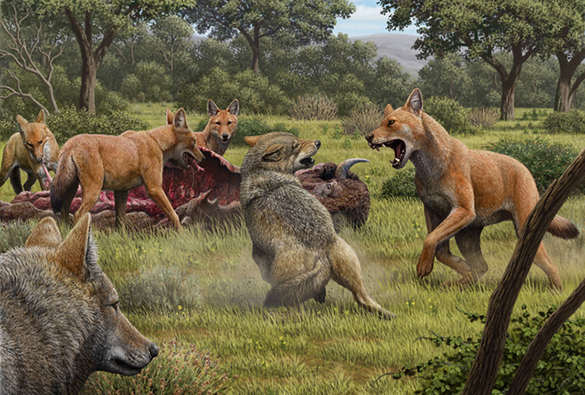
Extinct dire wolves split off from other wolves nearly six million years ago and were only a distant relative of today’s wolves, according to new research published in Nature.
Dire wolves, made famous by the TV show Game of Thrones, were common across North America until around 13,000 years ago, after which they went extinct.
The study, Dire Wolves were the last of an ancient New World canid lineage, shows that they were so different from other canine species, like coyotes and grey wolves, that they were not able to breed with each other. Previous analyses, based on morphology alone, had led scientists to believe that dire wolves were closely related to grey wolves.
The research was led by Durham University in the UK alongside scientists at the University of Oxford, Ludwig Maximilian University in Germany, the University of Adelaide in Australia and the University of California Los Angeles in the US.
Academics in the University of Liverpool’s Department of Archaeology, Classics and Egyptology were asked to test how the shape of dire wolves compared to grey wolves. Previous morphological projects in Liverpool had investigated dog domestication and the functional mechanics of canid bite, creating a huge sample of different canid species to assess for morphological differences.
Leverhulme Early Career Research Fellow, Dr Ardern Hulme-Beaman said: “By comparing the small differences in shape similarity between grey wolves and dire wolves with the large genetic differences, we were able to demonstrate that this is one of the biggest mismatches in the Canid family.
“Another example of a mismatch is between the coyote and the grey wolf. Despite these two species being extremely different in shape, genetically they’re very, very close.”
The international team sequenced the ancient DNA of five dire wolf sub-fossils from Wyoming, Idaho, Ohio, and Tennessee, dating back to over 50,000 years ago. Their analyses showed that dire wolves and grey wolves were in fact very distant cousins.
This is the first time ancient DNA has been taken from dire wolves, revealing the complex history of these ice age predators.
The collaboration of 49 researchers across nine countries analysed the genomes of dire wolves alongside those of many different wolf-like canid species. Their analyses suggest that unlike many canid species who apparently migrated repeatedly between North America and Eurasia over time, dire wolves evolved solely in North America for millions of years.
Although dire wolves overlapped with coyotes and grey wolves in North America for at least 10,000 years before their extinction, they found no evidence that they interbred with these species. The researchers suggest that their deep evolutionary differences meant that they were likely ill equipped to adapt to changing conditions at the end of the ice age.
Lead author, Dr Angela Perri from Durham University’s Archaeology Department, said: “Dire wolves have always been an iconic representation of the last ice age in the Americas and now a pop culture icon thanks to Game of Thrones, but what we know about their evolutionary history has been limited to what we can see from the size and shape of their bones and teeth.
“With this first ancient DNA analysis of dire wolves we have revealed that the history of dire wolves we thought we knew – particularly a close relationship to grey wolves – is actually much more complicated than we previously thought.
“Instead of being closely related to other North American canids, like grey wolves and coyotes, we found that dire wolves represent a branch that split off millions of years ago, representing the last of a now extinct lineage.”
Co-lead author, Dr Alice Mouton, from the University of California Los Angeles, added: “We have found the dire wolf is not closely related to the grey wolf. Further we show that the dire wolf never interbred with the grey wolf.
“In contrast, grey wolves, African wolves, dogs, coyotes and jackals can and do interbreed. Dire wolves likely diverged from grey wolves more than five million years ago, which was a great surprise that this divergence occurred so early. This finding highlights how special and unique the dire wolf was.”
The dire wolf is one of the most famous prehistoric carnivores from Pleistocene America which became extinct around 13,000 years ago. Known scientifically as Canis dirus, meaning ’fearsome dog’, they preyed on large mammals like bison. The team suggests the dire wolves’ stark evolutionary divergence from grey wolves places them in an entirely different genus – Aenocyon dirus (‘terrible wolf’)- as first proposed by palaeontologist John Campbell Merriam over 100 years ago.
Dire wolves were the last of an ancient New World canid lineage, Angela R. Perri, et al, published in Nature on 13 January 2021, DOI: 10.1038/s41586-020-03082-x